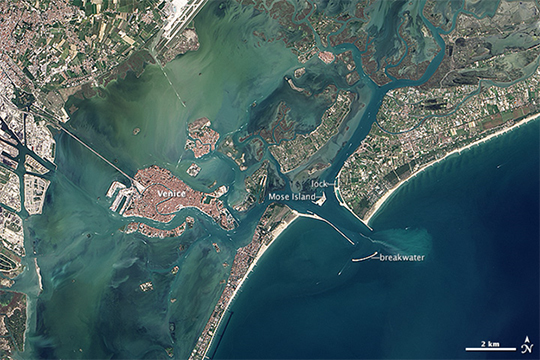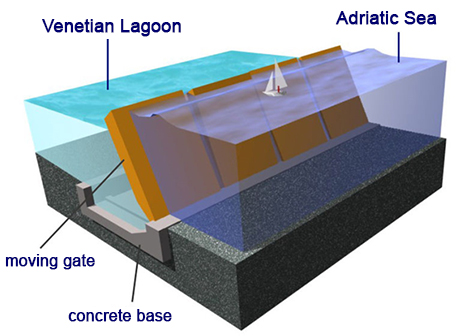
Just a few years ago, Venice, Italy, would flood more than 60 times a year. Until the Venetians decided to push back.
All that water was due to where Venice is built—in the middle of a lagoon. And why was it built there?
In the fifth century, Roman farmers, fleeing invaders, moved out to fishing huts on a string of low mud islands. Battered by tides, they built houses on stilts.
But their protection worked. While barbarians pillaged Italy, Venice thrived. Their settlement grew into a city, which grew into the greatest naval power in the Mediterranean—with the whole thing built on stilts.
Over the centuries, sediments beneath the city gradually compacted. The Venetians responded by jacking up their buildings farther.
But in the twentieth century, drilling and extraction of groundwater and natural gas caused the city to sink faster, while the Adriatic Sea level rose.
Tidal flooding became so frequent that Venice built a system of 79 enormous steel gates at the inlets to their lagoon. Each gate is 100 ft tall and weighs 300 tons. It rests flat on the seafloor—till an overly high tide is predicted.
Then, Venice pumps the gates full of air, and they slowly stand up, able to hold back 10 ft of ocean surge. When the threat is over, they sink back to the seafloor.
There are many other subsiding cities, like New Orleans, Miami, and Jakarta, keeping a watchful eye on the sea—and on the amazing gates of Venice.
Background
Synopsis: Venice—the city of water—grew to power over the centuries protected by the sea. But now the sea is encroaching on the self-

proclaimed “floating city,” which is a UNESCO World Heritage Site. Subsidence, extreme weather, and sea-level rise have combined to threaten this vulnerable municipality, but its citizens are fighting back with an audacious plan.
- Venice dates back to the fifth century fall of the Roman Empire, when farmers from the mainland fled to nearby marshes and sandy islands of the Venetian lagoon to escape advancing barbarians.
- The city originated as a group of small temporary fishing villages with houses built on stilts, but it eventually became a permanent settlement.
- For centuries, the sea protected Venice from enemy invaders. The lagoon is protected by a 28-mile chain of barrier islands.
- By the ninth century, Venice was an important fishing and business center, and the villages joined forces to create a single government with commerce and residences developing along the canals.
- “The Most Serene Republic of Venice” was the trading capital of Europe and amassed vast riches and art through the Middle Ages and Renaissance.
- The republic extended from eastern Italy to Croatia along the Adriatic Sea and established trading posts as far away as Greece and Turkey.
- Venice became a formidable Mediterranean power and even captured Constantinople, the Byzantine capital, in 1204.
- Declining in power after thirteen centuries, the city was captured by Napoleon when he invaded Italy in 1797.

- The city has been fighting back against the elements with the MOSE (MOdulo Sperimentale Elettromeccanico, or Experimental Electromechanical Module) Project, which began construction in 2003 and is expected to be operational by 2018.
- MOSE is a series of 79 movable steel gates across the three ocean inlets to the lagoon that would block up to 3 m (118 inches) of tides during extreme events.
- Each gate is 98 ft high, 65 ft wide, 16 ft thick, and weighs 300 tons.
- The gates remain hinged flat on the seabed in normal weather, but if high tides are predicted, compressed air is pumped into them; in about an hour they pivot upward to separate the lagoon from the sea. After the event, the gates are filled with water and drop back to the seabed.
- The acronym MOSE is no accident—just as Moses parted the Red Sea, Venetians are betting that the MOSE gates separate the Venetian Lagoon from the Adriatic Sea when the city is threatened.

